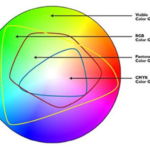To view overprints in Acrobat Reader, Pro or DC, open the source document, navigate to the “Preferences” option in the Acrobat menu. In the window that opens, highlight “Page Display” under “Category” in the left-hand pane. In the right-hand part of the window, locate the option “Use Overprint Preview” and select the option to the right from the drop-down choices, “Always”. Here’s a view of that setting:

Acrobat Pro and DC can “toggle” overprint preview, as well as view separations. For professionals in the printing industry that are viewing artwork for mechanical correctness, this is the correct and recommended way to view that artwork since this is how it will be separated to plates and go to press.
Separations are often mistakenly called “layers.” Layers are just that – different levels in a files that may contain different elements, like images, decoration or other features, placed on these different levels for mechanical reasons. Any number of different colours can exist on a single layer, but only one ink (or varnish or emboss or stamp, and so forth) can exist per separation.
To view separations and overprints in Acrobat Pro or DC, navigate to “Tools” and select and click “Print Production”.
In the pane that opens on the right-hand side of the viewport, select “Output Preview”.
In the Output Preview box that opens, note the option near the top of the window called “Simulate Overprinting”. By alternatively ticking and un-ticking this box, the displayed document will alternate between appearing with and without overprint.

Directly to the right of the “Simulate Overprint” option, Acrobat displays whether or nt overprint is present in the document being previewed. Separations can be toggled on and off by selecting the tick mark next to the colour name in the “Separations” pane on the lower half of the Output Preview window.
If there are layers in the file being viewed, those can be viewed by clicking the right-facing arrow on the left-most edge of the displayport. 
Several icons will become visible above the arrow’s location. Click on the icon that looks like layers of sheets of paper.

Whatever layers that are present will appear in the Layers tab that opens. Clicking on the eye icon will turn individual layers on or off.This feature is not meant to check colour separations.

Checking seps should be done ONLY with all layers on, just as the file would be used for production. Otherwise, there is a reasonable chance that an element on a turned-off layer that will interact with the rest of the art in the document when the going to press will not be noticed.



